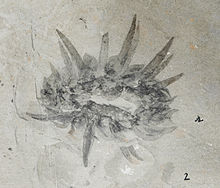Our website is made possible by displaying online advertisements to our visitors.
Please consider supporting us by disabling your ad blocker.
Wiwaxia
| Wiwaxia Temporal range: Early Cambrian to Middle Cambrian (Stage 3 to Wuliuan),
Possible record of Late Cambrian and Ordovician period
| |
|---|---|

| |
| Fossil showing underside of Wiwaxia corrugata from the Burgess Shale. From Smith (2014) | |
| Scientific classification | |
| Domain: | Eukaryota |
| Kingdom: | Animalia |
| Superphylum: | Lophotrochozoa |
| Phylum: | Mollusca (?) |
| Family: | †Wiwaxiidae Walcott, 1911 |
| Genus: | †Wiwaxia Walcott, 1911 |
| Species | |
Wiwaxia is a genus of soft-bodied animals that were covered in carbonaceous scales and spines that protected it from predators. Wiwaxia fossils—mainly isolated scales, but sometimes complete, articulated fossils—are known from early Cambrian and middle Cambrian fossil deposits across the globe.[4][6][7] The living animal would have measured up to 5 centimetres (2 in) when fully grown, although a range of juvenile specimens are known, the smallest being 2 millimetres (0.08 in) long.[7]
Wiwaxia's affinity has been a matter of debate: Researchers were long split between two possibilities. On the one hand, its rows of scales looked superficially similar to certain scale worms (annelids); conversely, its mouthparts and general morphology suggested a relationship to the shell-less molluscs. More recently, evidence for a molluscan affinity has been accumulating, based on new details of Wiwaxia's mouthparts, scales, and growth history.[7][8] The name derives from Wiwaxy Peak in British Columbia.[9]
The proposed clade Halwaxiida contains Wiwaxia as well as several similar Cambrian animals.
- ^ Cite error: The named reference
Kimming-etal-2019was invoked but never defined (see the help page). - ^ Cite error: The named reference
Yang-etal-2014was invoked but never defined (see the help page). - ^ Zhang, Zhifei; Smith, Martin R.; Shu, Degan (2015). "New reconstruction of the Wiwaxia scleritome, with data from Chengjiang juveniles". Scientific Reports. 5: 14810. Bibcode:2015NatSR...514810Z. doi:10.1038/srep14810. PMC 4595806. PMID 26443243.
- ^ a b Cite error: The named reference
Zhao1994was invoked but never defined (see the help page). - ^ Morris, Simon Conway; Selden, Paul A.; Gunther, Glade; Jamison, Paul G.; Robison, Richard A. (2015). "New records of Burgess Shale-type taxa from the middle Cambrian of Utah". Journal of Paleontology. 89 (3): 411–423. Bibcode:2015JPal...89..411C. doi:10.1017/jpa.2015.26. ISSN 0022-3360. S2CID 55050961.
- ^ Cite error: The named reference
ConwayMorris1985was invoked but never defined (see the help page). - ^ a b c Cite error: The named reference
Smith2014was invoked but never defined (see the help page). - ^ Smith, M.R. (2012). "Mouthparts of the Burgess Shale fossils Odontogriphus and Wiwaxia: Implications for the ancestral molluscan radula". Proceedings of the Royal Society B. 279 (1745): 4287–4295. doi:10.1098/rspb.2012.1577. PMC 3441091. PMID 22915671.
- ^ "Wiwaxia corrugata". Burgess Shale. Royal Ontario Museum.
Previous Page Next Page


